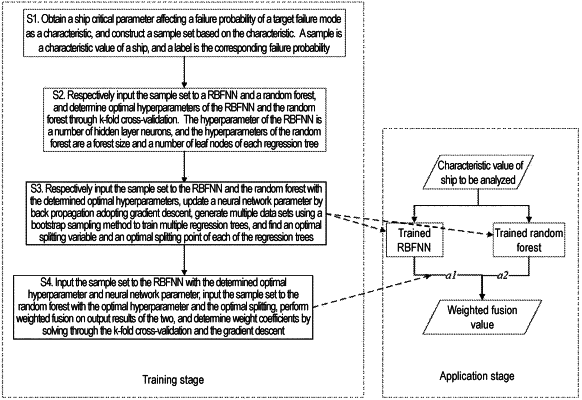| CPC G06F 30/27 (2020.01) [B63B 39/00 (2013.01); B63B 71/00 (2020.01); G06N 3/09 (2023.01); B63B 43/04 (2013.01)] | 14 Claims |

|
1. A method for ship stability prediction by weighted fusion of radial basis function neural network (RBFNN) and random forest based on gradient descent, the method comprising:
a training stage, comprising:
Step S1 of obtaining a ship critical parameter affecting a failure probability of a target failure mode is as a characteristic, and constructing a sample set based on the characteristic, wherein a sample is a characteristic value of a ship, and a label is the corresponding failure probability;
Step S2 of respectively inputting the sample set to the RBFNN and the random forest, and determining optimal hyperparameters of the RBFNN and the random forest through k-fold cross-validation, wherein the hyperparameter of the RBFNN is a number of hidden layer neurons, and the hyperparameters of the random forest are a forest size and a number of leaf nodes of each regression tree;
Step S3 of respectively inputting the sample set to the RBFNN and the random forest with the determined optimal hyperparameters, updating a neural network parameter by back propagation adopting the gradient descent, generating a plurality of data sets using a bootstrap sampling method to train a plurality of regression trees, and finding an optimal splitting variable and an optimal splitting point of each of the regression trees; and
Step S4 of inputting the sample set to the RBFNN with the determined optimal hyperparameter and network parameter, inputting the sample set to the random forest with the optimal hyperparameter and the optimal splitting, performing weighted fusion on output results of the two, and determining weight coefficients by solving through the k-fold cross-validation and the gradient descent; and
an application stage, comprising:
obtaining the characteristic value of a ship to be analyzed and respectively inputting the characteristic value to the trained RBFNN and the trained random forest, wherein a weighted fusion value of the output results of the two is a stability prediction result of the ship to be analyzed in the target failure mode.
|